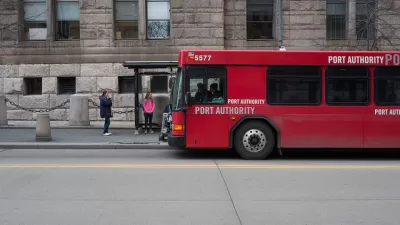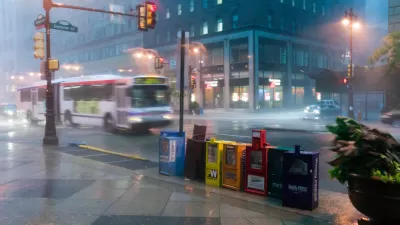The process of reducing the number of stops on a transit line—known as bus stop thinning, consolidation, or balancing—took effect this week in Cincinnati. Reducing the number of stops is intended to speed up buses and improve reliability.

"Cincinnati Metro riders using hundreds of the bus system's stops -- including some serving Cincinnati Public Schools' high school students -- had to catch their ride at a new location Monday morning, after the transit authority removed 400 stops over the weekend," reports Pat LaFleur.
The 400 stops were removed in the third phase of the FAStops program, launched a year ago with the intention of speeding up Cincinnati Metro buses.
"The theory behind the FAStops plan is to optimize bus stop spacing in order to keep buses moving more efficiently along their routes, Cincinnati Metro spokeswoman Brandy Jones told WCPO in 2018, shortly after the transit agency announced the program."
LeFleur's coverage of the stop removals focuses on the impact of the program on Metro lines serving routes to schools in the Cincinnati Public Schools system.
FULL STORY: Cincinnati Metro program removed hundreds of bus stops over the weekend

Maui's Vacation Rental Debate Turns Ugly
Verbal attacks, misinformation campaigns and fistfights plague a high-stakes debate to convert thousands of vacation rentals into long-term housing.

Planetizen Federal Action Tracker
A weekly monitor of how Trump’s orders and actions are impacting planners and planning in America.

In Urban Planning, AI Prompting Could be the New Design Thinking
Creativity has long been key to great urban design. What if we see AI as our new creative partner?

King County Supportive Housing Program Offers Hope for Unhoused Residents
The county is taking a ‘Housing First’ approach that prioritizes getting people into housing, then offering wraparound supportive services.

Researchers Use AI to Get Clearer Picture of US Housing
Analysts are using artificial intelligence to supercharge their research by allowing them to comb through data faster. Though these AI tools can be error prone, they save time and housing researchers are optimistic about the future.

Making Shared Micromobility More Inclusive
Cities and shared mobility system operators can do more to include people with disabilities in planning and operations, per a new report.
Urban Design for Planners 1: Software Tools
This six-course series explores essential urban design concepts using open source software and equips planners with the tools they need to participate fully in the urban design process.
Planning for Universal Design
Learn the tools for implementing Universal Design in planning regulations.
planning NEXT
Appalachian Highlands Housing Partners
Mpact (founded as Rail~Volution)
City of Camden Redevelopment Agency
City of Astoria
City of Portland
City of Laramie





























